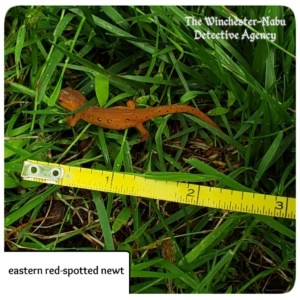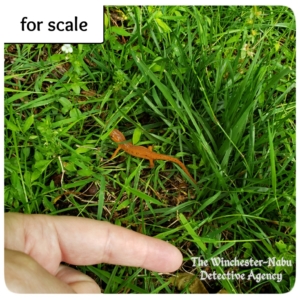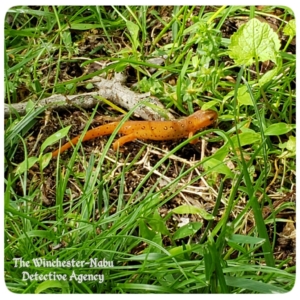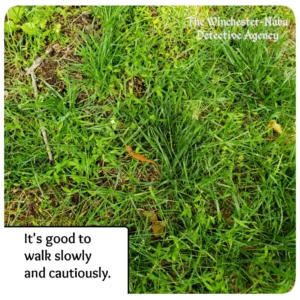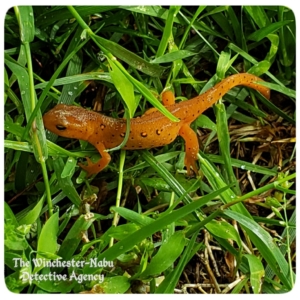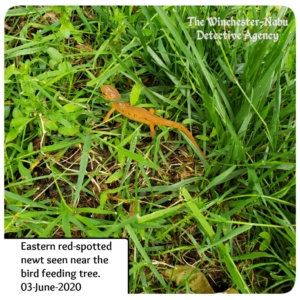Winchester-Nabu Detective Agency Year Four:
Case File No. 12-168
AMBER LOVE 03-AUG-2020 Find out how all this began. Catch up on Year One, Year Two, and Year Three cases at the Winchester-Nabu Detective Agency. Thank you for all your financial and social support! Oliver and Gus are looking forward to bringing you more fascinating discoveries and investigations into the chipmunk mafia, the blue jay gang, the neighborhood critters, and cryptid sightings.
This work is supported by the generous backers who adore my cat stories at Patreon.com/amberunmasked and they also get first access to what’s happening with my books and podcast. For a one-time tip, you can go to the new PayPal.me.
Where We Left Off:
A pair of mourning doves roosted in the junkyard in a place that was easy for us to observe and make notes.
Reign of Fire:
Look out, northern witches — I saw a fire elemental today 🔥. On patrol today, Gus and I had another first! First encounter with an 🦎 Eastern Spotted Newt. This was found at the edge of the shrubbery behind the small red maple where we feed the birds and squirrels. I looked up information about this little creature and learned some incredible things. The red spots are warnings to predators that these little guys secrete tetrodotoxin (like puffer fish🐡)! And if that doesn’t scare someone off, they take on a posture quite like a cat, arching their backs and being rigid. Totally Halloween Cat! It’s called the Unken Reflex.
“The Eastern spotted Newt, New Jersey’s only newt species, starts off its life as an egg, laid individually, wrapped inside the leaf of an aquatic plant in Spring, left to develop on its own with no protection or guidance from its parent – orphaned. The larvae hatch three to five weeks later and then transform into the terrestrial eft stage emerging from there aquatic beginnings to travel the landscape for four to seven years.” John Parke, nj.com
This Red Eft stage while the newt lives in the woods lasts a few years.
“After a few years of roaming the forest floor, a remarkable transition occurs. The skin of the newt becomes slimy and changes from reddish-orange to olive green. The tail becomes broad and wedge-shaped.” John Parke, nj.com
After it changes shape and color, the newt heads back to the water for mating and to retire. I needed a bit of a Biology 101 refresher and had to look up what makes a salamander not a lizard. The distinguishing difference is that salamanders are amphibians therefore related to, but not lizards or reptiles. I still find it confusing. Amphibians: frogs, toads, newts, and salamanders. Reptiles: snakes, lizards, crocodiles, and turtles. The key lies in how they breathe. Amphibians have gills and grow lungs. Reptiles have lungs. There is no metamorphosis in the growth stages for reptiles either.
A mere newt? What if it’s not?
When I met this graceful little thing, I kept thinking about “the firevurm” (fire worm) from a movie I honestly never sat through, The 13th Warrior starring Antonio Banderas. Villagers believed the land-consuming fire worm was a dragon or such creature before they learned it was a massive army carrying torches.
Oliver and I previously researched different reptilian monsters and critters when we started finding Gorgons around the estate. The creature we encountered had four legs and no wings (at least none that had grown in at this red eft stage). Wyvern are supposed to have only two legs and have wings. This was something we uncovered previously. Lindworm are wingless dragons. Though again, the research is flawed and lacking. Some depictions in art show the lindworms and wyverns as both having wings, some show wings with no legs, or wings with two legs. It’s all terribly confusing. Nonetheless, what we can determine is that it’s the same as other hierarchies of taxonomy. All these reptilian creatures fall under the classification of dragons, no matter their size nor associated element. Sea dragons are freaking cool!
During the type of pagan rituals I’ve worked in, if it’s a long formal rite, the elementals are called to join the circle. with their kings and queens. An example would be:
“In the South, Uriel, King Djinn, and all the salamanders of Fire. Welcome.”
As with the confusion of the dragons, there is plenty to make research confusing with elementals, angels, and rulers. You might find Ariel instead of Uriel; Djin instead of Djinn. Not to mention that in the Cabot Tradition, East is Fire, not the South. Each witch’s mileage may vary.
“Dragon of the East, Power of Fire, we welcome you to this circle. So mote it be.” — Laurie Cabot’s Book of Spells & Enchantments
If you’re familiar with the Spider-Man villain, the Lizard, you may recall his origin story as a scientist who was looking for regenerative powers found in nature. Wanting to grow back a lost appendage, Dr. Curt Connors used lizards for his experimentation. He could have used starfish, but I guess that wasn’t as cool. Oh, Marvel! DC made Starro scary.
Are elementals physical or spiritual?
Here we face another question that has various answers depending on the source. Since salamanders are often found near logs, they would be present when people looked for firewood. Supposedly this began an association between the salamandridae family and fire. At a quick glance through a couple of new age websites, they say the 16th century physician Paracelsus is responsible for naming and associating the four cardinal elementals: salamanders, gnomes, slyphs, and undines. At this point, who’s to know? Things might not have been written down or mistranslated and besides, women were never consulted.
I mentioned the comic book characters of Marvel and DC briefly. One character that I know little about is DC’s African hero Vixen. She has a necklace and blood lineage to command the powers/strengths of animals. In the cartoons, the artists draw the animal she’s channeling as transparent and consuming energy that is tied to Vixen. Depending on the animal channeled, her abilities change. That’s the best example of how I can describe what I think the elementals are like. Perhaps they cross through a veil separating realities or realms; or they’re simply things we don’t see.
This little newt was an elemental host. We had a blazing hot June most of the time. People had short tempers or no patience (fiery personalities) with the pandemic closures.
What does this mini dragon have in store? What brought it to our little hill?
Case Findings:
We discovered a fire elemental attached to the physical body of a red spotted newt. Fortunately, Gus did not try to lick it or bite it as he and Oliver have done with the toxic toad creatures. This little dragon’s poison will be used on other predators. She brought a heatwave and the official mark of midsummer. While we don’t know why this specific location was part of her life journey into the woods, it was a wicked encounter.
Case Status: Closed


